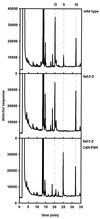Lignin monomer composition is determined by the expression of a cytochrome P450-dependent monooxygenase in Arabidopsis
- PMID: 9618461
- PMCID: PMC22575
- DOI: 10.1073/pnas.95.12.6619
Lignin monomer composition is determined by the expression of a cytochrome P450-dependent monooxygenase in Arabidopsis
Abstract
The phenylpropanoid pathway provides precursors for the biosynthesis of soluble secondary metabolites and lignin in plants. Ferulate-5-hydroxylase (F5H) catalyzes an irreversible hydroxylation step in this pathway that diverts ferulic acid away from guaiacyl lignin biosynthesis and toward sinapic acid and syringyl lignin. This fact led us to postulate that F5H was a potential regulatory step in the determination of lignin monomer composition. To test this hypothesis, we have used Arabidopsis to examine the impact of F5H overexpression. Arabidopsis is a useful model system in which to study lignification because in wild-type plants, guaiacyl and syringyl lignins are deposited in a tissue-specific fashion, while the F5H-deficient fah1 mutant accumulates only guaiacyl lignin. Here we show that ectopic overexpression of F5H in Arabidopsis abolishes tissue-specific lignin monomer accumulation. Surprisingly, overexpression of F5H under the control of the lignification-associated cinnamate-4-hydroxylase promoter, but not the commonly employed cauliflower mosaic virus 35S promoter, generates a lignin that is almost entirely comprised of syringylpropane units. These experiments demonstrate that modification of F5H expression may enable engineering of lignin monomer composition in agronomically important plant species.
Figures





Similar articles
-
NMR characterization of lignins in Arabidopsis altered in the activity of ferulate 5-hydroxylase.Proc Natl Acad Sci U S A. 1999 Oct 26;96(22):12328-32. doi: 10.1073/pnas.96.22.12328. Proc Natl Acad Sci U S A. 1999. PMID: 10535921 Free PMC article.
-
Modified lignin in tobacco and poplar plants over-expressing the Arabidopsis gene encoding ferulate 5-hydroxylase.Plant J. 2000 May;22(3):223-34. doi: 10.1046/j.1365-313x.2000.00727.x. Plant J. 2000. PMID: 10849340
-
Overexpression of ferulate 5-hydroxylase increases syringyl units in Sorghum bicolor.Plant Mol Biol. 2020 Jun;103(3):269-285. doi: 10.1007/s11103-020-00991-3. Epub 2020 Mar 13. Plant Mol Biol. 2020. PMID: 32170550
-
Trends in lignin modification: a comprehensive analysis of the effects of genetic manipulations/mutations on lignification and vascular integrity.Phytochemistry. 2002 Oct;61(3):221-94. doi: 10.1016/s0031-9422(02)00211-x. Phytochemistry. 2002. PMID: 12359514 Review.
-
[Advances in research on lignin biosynthesis and its genetic engineering].Zhi Wu Sheng Li Yu Fen Zi Sheng Wu Xue Xue Bao. 2004 Aug;30(4):361-70. Zhi Wu Sheng Li Yu Fen Zi Sheng Wu Xue Xue Bao. 2004. PMID: 15627683 Review. Chinese.
Cited by
-
Fiber Cell-Specific Expression of the VP16-Fused Ethylene Response Factor 41 Protein Increases Biomass Yield and Alters Lignin Composition.Front Plant Sci. 2021 Apr 30;12:654655. doi: 10.3389/fpls.2021.654655. eCollection 2021. Front Plant Sci. 2021. PMID: 33995450 Free PMC article.
-
Evidence for poplar PtaPLATZ18 in the regulation of plant growth and vascular tissues development.Front Plant Sci. 2023 Dec 21;14:1302536. doi: 10.3389/fpls.2023.1302536. eCollection 2023. Front Plant Sci. 2023. PMID: 38186608 Free PMC article.
-
Syringyl lignin biosynthesis is directly regulated by a secondary cell wall master switch.Proc Natl Acad Sci U S A. 2010 Aug 10;107(32):14496-501. doi: 10.1073/pnas.1009170107. Epub 2010 Jul 26. Proc Natl Acad Sci U S A. 2010. PMID: 20660755 Free PMC article.
-
NMR characterization of lignins in Arabidopsis altered in the activity of ferulate 5-hydroxylase.Proc Natl Acad Sci U S A. 1999 Oct 26;96(22):12328-32. doi: 10.1073/pnas.96.22.12328. Proc Natl Acad Sci U S A. 1999. PMID: 10535921 Free PMC article.
-
Overexpression of the scopoletin biosynthetic pathway enhances lignocellulosic biomass processing.Sci Adv. 2022 Jul 15;8(28):eabo5738. doi: 10.1126/sciadv.abo5738. Epub 2022 Jul 13. Sci Adv. 2022. PMID: 35857515 Free PMC article.
References
-
- Higuchi T. In: Plant Carbohydrates II. Tanner W, Loewus F A, editors. New York: Springer; 1981. pp. 194–224.
-
- Lewis N G, Yamamoto E. Annu Rev Plant Physiol Plant Mol Biol. 1990;41:455–496. - PubMed
-
- Mizutani M, Ward E, Ohta D, Ryals J, Sato R. Biochem Biophys Res Commun. 1993;190:875–880. - PubMed
-
- Grand C. FEBS Lett. 1984;169:7–11.
LinkOut - more resources
Full Text Sources
Other Literature Sources
Molecular Biology Databases

